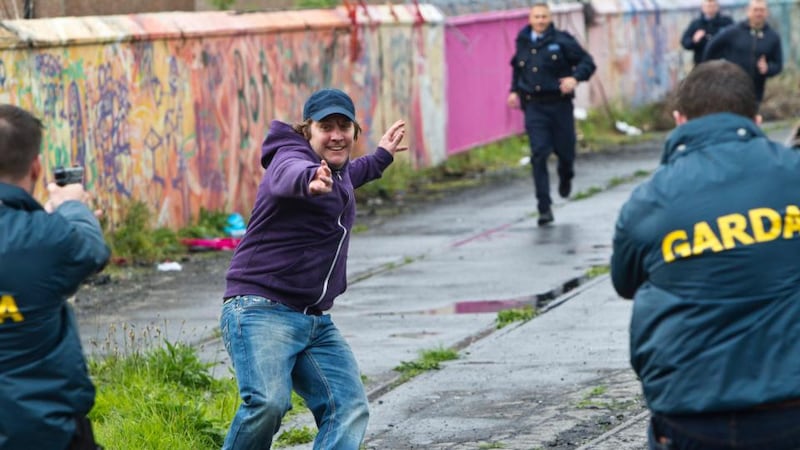When the final episode of Love/Hate's fifth series drew to a close, last Sunday night, viewers had been challenged in a rare way. The prison rape of Fran was a barbaric act of premeditated cruelty. Many viewers may have looked away or turned the volume down, so graphic was the violence.
The bloodbath finale to RTÉ's gangland drama began with the discovery of the tortured, lifeless body of the brothel keeper Janet and ended with the accidental shooting of Siobhan and deliberate gunning down of Nidge, viewed by his wife and young son.
The uncomfortable truth is that the programme’s most violent moments are based on reality. Reported acts of violence in prisons are rare. In almost a decade writing about crime, this reporter can recall reporting on only one such case. In 1998, however, in the Maze, an LVF prisoner, David Keys, was left for dead after being tortured severely.*

Keys, on remand for sectarian murder, was attacked on suspicion of being an informer. After he had been stabbed and tortured*, he was strangled to death. His killers hung his body from a cell window, to make it appear he had taken his own life.
The coroner, John Leckey, limited himself to saying that the 26-year-old was “murdered in a particularly brutal and sadistic way”.*
Prison attack
In Mountjoy Prison, in Dublin, in August 2006 Gary Douch was stamped to death in a crowded basement cell by a mentally ill prisoner who then defecated and smeared excrement on his victim. Although not a gangland crime, it was a prison attack every bit as barbaric as that depicted on our television screens last weekend.
The assault on Fran – in retaliation for urinating on the grave of the mother of his chief attacker, Noely – captured the way that the walls of a prison are no barrier to the outside world.
At any time about a third of the 3,800-4,000 prisoners in the Republic are in protective custody because of fears of an attack related to events inside or outside the prison.
In reality, a prisoner, such as Fran, who finds himself on the same wing as an adversary would likely request to be placed in protective custody or transferred.
But prisoners keen to stand their ground could be reluctant to flinch in the face of a perceived threat of attack, for fear of being seen as weak.
The depiction of Nidge's son seeing his father murdered is also no exaggeration. In August, by when filming on Love/Hate was finished, Andy Connors, a 45-year-old, was shot dead at his home, in Saggart, in southwest Dublin. The fatal attack was witnessed by some of his six young children.
In September 2006 Declan O’Reilly, a Dublin, was shot dead on South Circular Road. His 11-year-old son was with him when the gunman opened fire – as Warren was with Nidge – and witnessed the murder. These are just two of many such cases.
The shooting of Siobhan in last Sunday’s episode was collateral damage from when Patrick, the pipe-bomb maker, attacked Nidge. She was an unintended victim.
In real life Melanie McCarthy-McNamara, a 16-year-old was shot fatally in the head as she sat in a car outside a house in Tallaght on February 8th, 2012. The gunman was targeting a man but shot the teenager by mistake in a drive-by attack – the same type of attack that Patrick used when he fired the shots that killed Siobhan.
In a similar scenario last September, Benny Whitehouse’s wife was wounded when he was shot dead just moments after leaving his young daughter to a primary school in Balbriggan, north Co Dublin.
Worst of the violence
Of all of the violence in last Sunday’s episode, and perhaps in the five series to date, the manner of Janet’s murder, involving her legs being cut open with a power tool while she was still alive, stretched credulity the most.
Janet was killed because she was tenuously suspected of being an informer and to send a signal to others who may be informing. The exact mode of her torture is uncommon in the Republic, but people have been tortured in cruel circumstances.
In 2003 Michael Campbell McNamara, who was 23, was lured to his death in a field in Rathbane, Limerick, on the promise of being sold a sawn-off shotgun. His hands and feet were bound by members of one of the city’s gangs before he was stabbed 10 times and then shot in the pelvis and, fatally, in the head.
And, in April 2008, James Cronin was fatally shot in the head in Limerick based on the slimmest of fears that he would turn Garda informer.
Perhaps the most accurate portrayal of the Irish criminal underworld was the relationship in the latest series of Love/Hate between Terence, the Spain-based drug wholesaler, and the show's anti-hero crime boss, Nidge.
Although he was regarded by other Irish characters as a key player in Dublin crime, Nidge was simply another retailer into whose gang the Irish-led crime syndicate in Spain was supplying drugs in vast quantities.
In the real underworld, gangs here all work for a Spain-based Irish cartel headed by a middle-aged Dublin drug dealer.
The dispatch of Terence’s nephew Pauley to Ireland to shore up Nidge’s operation, so that a drugs debt could be repaid, also mirrors the direct intervention by the Spanish-Irish cartel in gangland affairs back home.
The 2010 murder of Eamon Dunne is one such case. Dunne was gunned down on the orders of the Irish-led gang in Spain because all the murders he was committing were destabilising the Dublin drug market.
The murder of Nidge also maintained the authenticity of Love/Hate, reflecting the fact that, in the real world, men like him often don't see their 40th birthdays.
* This article was edited on June 8th, 2016












